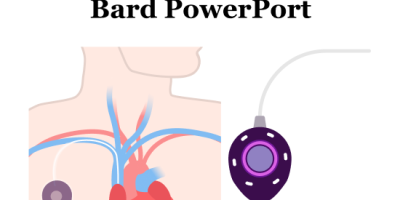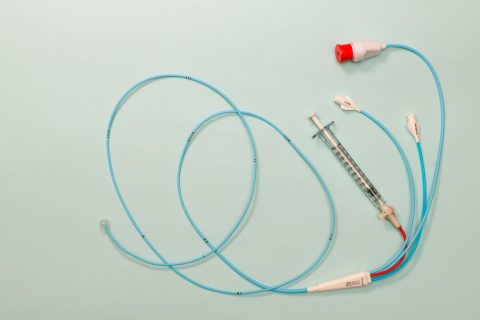Bard PowerPort Complications
Bard PowerPort complications include blood clots, cardiac punctures, bleeding and a rare but serious complication called pinch-off syndrome. The company faces lawsuits over claims that defective devices may facture or migrate. These defects could lead to infection, respiratory issues, organ damage and death.
- Last update: June 18, 2025
The Bard PowerPort is supposed to help patients safely receive medications and fluids. But some people have suffered serious problems after getting the device. In many cases, the catheter has broken or moved from where it was placed. This can lead to infections, blood clots, internal bleeding and other dangerous health issues.
Because of these risks, many patients are filing Bard PowerPort lawsuits for damages they received from the device. They say the PowerPort is defective and that the company didn’t do enough to warn people. Some families have also filed wrongful death claims. Many of these lawsuits are now part of a larger group case called multidistrict litigation (MDL).
Common Bard PowerPort Complications and Risks
The Bard PowerPort may lead to complications such as breathing difficulty, abnormal heart rhythms and more. The complications patients experience depend on their general health and the most serious complications are generally rare.
However, if the PowerPort is defective, it may fracture or migrate, causing serious injuries.
- Air embolism
- Allergic reaction
- Bleeding
- Brachial plexus injury
- Cardiac arrhythmia
- Cardiac puncture
- Cardiac tamponade
- Catheter or port erosion through the skin
- Catheter embolism
- Catheter occlusion
- Damage or breakage due to compression between the clavicle and first rib
- Catheter or port-related sepsis
- Device rotation or extrusion
- Endocarditis
- Extravasation
- Fibrin sheath formation
- Guidewire fragment embolism
- Hematoma
- Hemothorax
- Hydrothorax
- Infection, including but not limited to pocket, catheter tunnel and/or bloodstream
- Inflammation, necrosis or scarring of skin over implant area
- Intolerance or reaction to implanted device
- Laceration of vessels or viscus
- Pain at or around port pocket site
- Perforation of vessels or viscus
- Pneumothorax
- Spontaneous catheter tip malposition or retraction
- Thoracic duct injury
- Thromboembolism
- Vascular thrombosis
- Vessel erosion
Complications from a Bard PowerPort may include signs of infections such as fever, confusion or inflammation. While some issues are reversible with treatment, others, such as kidney damage, are more permanent.
Serious Complications of Bard PowerPort Devices
Serious complications of Bard PowerPorts involve issues that could indicate organ damage, such as abnormal heart rate and urinary changes. If a catheter fractures, fragments enter the bloodstream and can puncture organs and rupture blood vessels.
- Arrhythmia
- Bloody cough
- Chest pain
- Confusion
- Fever
- Headaches
- Pinch-off syndrome
- Sepsis
- Shortness of breath
- Urinary changes
A defective Bard PowerPort is susceptible to bacteria, and infection can be a severe side effect. Without treatment, an infection in the bloodstream can lead to sepsis, a life-threatening condition that affects the entire body.
Bard PowerPort Pinch-Off Syndrome
Another rare but serious Bard PowerPort complication is pinch-off syndrome. Pinch-off syndrome occurs when the catheter is pinched between the clavicle and the rib, blocking the tubing. Signs of pinch-off syndrome may include difficulty passing fluids through the catheter or drawing blood.
If medical providers suspect a pinch-off, they will check the catheter with an X-ray to confirm it. In cases of severe pinch-off or pinch-off that causes a device fracture, patients may require surgery to remove the catheter.
Serious Injuries Resulting from PowerPort Complications
The most significant injuries caused by defective PowerPort devices are punctures to sensitive organs, such as the heart and kidneys. This type of injury can result in sudden organ failure, which can be challenging to treat.
Bard PowerPort complications involve damage to the implantable catheter device caused by high medication flow rates and brittle tubing, according to lawsuits. Patients who filed lawsuits allege the Bard PowerPort catheter is prone to fractures, which result in bacterial build-up and a loss of integrity.
A combination of the flawed material and degradation by bacteria leads to breakage in the catheter, according to lawsuits. During use, tiny plastic fragments break free into the bloodstream. These plastic shards can puncture blood vessels and sensitive organs.
- Bleeding (hemorrhage)
- Blood clots (embolism and thrombosis)
- Death
As fractured pieces of the catheter travel in the bloodstream, they can damage and rupture blood vessels, causing bleeding. Depending on location, if this bleeding occurs in an artery that feeds a sensitive organ, such as the brain or lungs, it can be fatal.
Similarly, plastic fragments from defective devices can promote the formation of blood clots. When a blood clot forms within a blood vessel it is called thrombosis. An embolism occurs when a piece of the clot breaks off and travels elsewhere. In the lungs, a pulmonary embolism can make breathing difficult or painful. If not treated quickly, the loss of oxygen can result in death.
Reports also indicate that the Bard PowerPort can move or migrate from its implantation site. As it progresses, the flexible tubing attached to the device can cause damage while traveling out of the blood vessels. Depending on the severity of the injury, emergency surgery may be necessary to remove the device and prevent further damage.
Can PowerPort Complications Be Prevented?
You can prevent complications from a Bard PowerPort by being aware of the potential issues and talking with your doctor about possible complications. You can check the history of Bard PowerPort recalls and identify whether your device model has been affected.
- During treatment, ask your nurse or doctor about the status of your PowerPort.
- Identify signs of infection, such as fever or inflammation.
- Keep the PowerPort site clean by following directions from your provider.
- Tell your doctor about any pain or redness at the PowerPort site.
- Watch for any bruises, other signs of bleeding or changes in your urine.
Ask your provider whether your device has been recalled and whether it should be removed or replaced. Knowing the signs of Bard PowerPort complications could save your life.
When to See a Doctor For PowerPort Complications
If you have a Bard PowerPort, you are likely in active treatment and already see your doctor on a set schedule. However, if complications arise between your treatment cycles, you should know when to see your doctor outside of scheduled visits.
- Concerns that your PowerPort may be malfunctioning or dislodged
- Fever, confusion, pain or swelling
- New changes to existing symptoms, such as increased cough
- Signs of bleeding or blood clots, such as bruises or leg pain
The sooner you see a doctor, the more likely they can reverse or prevent any further damage caused by a Bard PowerPort. Keep your provider’s emergency contact number available in case of a sudden severe issue, and have a plan if you need a ride to the hospital.
Calling this number connects you with a Drugwatch.com representative. We will direct you to one of our trusted legal partners for a free case review.
Drugwatch.com's trusted legal partners support the organization's mission to keep people safe from dangerous drugs and medical devices. For more information, visit our partners page.






